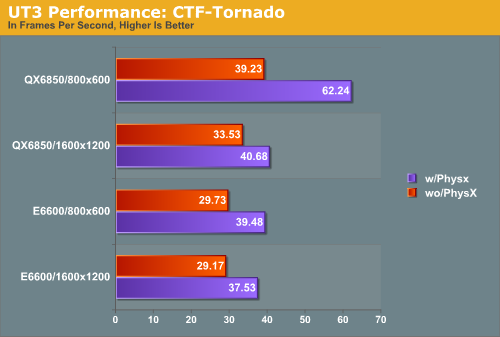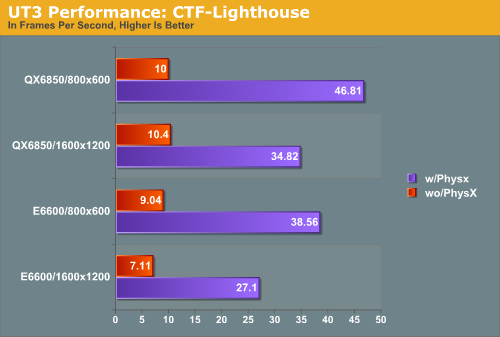PhysX’s Big Break? Unreal Tournament 3 PhysX Performance
by Ryan Smith on December 14, 2007 12:00 AM EST- Posted in
- GPUs
PhysX Performance Under UT3: AGEIA’s Maps
To start things off, we’ll begin with the physically demanding situations from AGEIA’s map pack before moving on to the stock UT3 maps. As AGEIA’s showpieces, these maps will trend to being PPU limited.


Although UT3 isn’t a particularly resource-hogging game, it does tend to be GPU limited more than any other situation. We see that on our 1600x1200 tests, where CTF-Tornado performs very similarly with both of our processors when PhysX enabled. What we end up with overall are very balanced results that show that everything can be a bottleneck at some point.
As we hinted at earlier, CTF-Tornado is generally playable with or without the PhysX PPU with any of our setups. Adding the PPU adds anywhere between 20-25% in our more realistic 1600x1200 situations, to 30-60% when we move away from the GPU bottleneck. However what the benchmarks don’t show is the performance of the map at its lowest; UT3 doesn’t give us the lowest frame rate values for these situations, but when staring directly in to the tornado – the most physically demanding action on this map – performance is certainly dropping in to the single digits. This is fine for bot matches, but this would be impractical for online play.
CTF-Lighthouse on the other hand shows massive performance improvements, and is completely unplayable without a PPU, where it’s literally a slideshow. Adding the PPU increases performance by a minimum of 280%, a welcome change from the PPU driving performance down in some of our past benchmarks. Even with the PPU however, CTF-Lighthouse struggles to be smooth at times, staying just on the side of playability. With no real way to vary the physics load we can’t test all possible options, but we believe it’s very likely that we’re PPU limited on this map, certainly at 800x600 when the GPU bottleneck is removed.
We also have a quick look at CPU usage for UT3 when running this map, to get an idea of just how well the CPU is being used; if it’s not being well used by the software PhysX simulations, then CTF-Lighthouse in particular is not a fair comparison. UT3 is designed around dual-core processors with some light helper threads to occupy cores 3 and 4, so if physics are the bottleneck then the multithreaded software PhysX simulations should be able to completely load the CPU.

However we are not seeing this. CPU usage is hovering at a little below 60% total usage on our QX6850. Given that we're not GPU limited, one thread in particular must be the CPU limited thread, and isn't capable of being further split. Our first thought is that the thread(s) that handle game logic also are doing the software physics, which would explain why we're not seeing a greater use of the other cores for the physics calculations. It's unfortunate if this is the case though, as it means that Unreal Tournament 3 (and possibly other Unreal Engine 3 games) is unable to fully utilize more than 2 cores and change. It also means that we potentially could be getting better software performance, which works against the PhysX hardware.
Never the less, this map is certainly designed to be a best-case scenario for the hardware, which is exactly what it delivers.










29 Comments
View All Comments
SignalPST - Friday, December 14, 2007 - link
On a unrelated note, does anyone know if the retail game shipped includes high resolution textures? People were complaining that the demo didn't include it, and the in-game graphics don't compare with anything like those eye-popping screenshots Epic teased us with.cubanx - Friday, December 14, 2007 - link
They are included but not the default. If you mess around with the settings you can get quality near the screen shots they released .Here's one tweak guide http://www.tweakguides.com/UT3_1.html">http://www.tweakguides.com/UT3_1.html
Dainas - Friday, December 14, 2007 - link
....And yet there still is NO PCIe PhysX card available for purchase.Heres another question for AGEIA; with dwindling PCI classic slots on todays motherboard, how do they expect people to use their products if there's no where to put it?
poohbear - Friday, December 14, 2007 - link
i hear u man. i have 1 soundcard and 1 wifi card and my other pci slot is blocked by the aftermarket cooler on my x1900xt, so there's simply no room for this card on pci even if i wanted to buy it.:pgoku - Monday, December 17, 2007 - link
get an ethernet to wifi converter, that way you can use the onboard ethernet on your motherboard.http://www.dslreports.com/shownews/Buffalo-Launche...">http://www.dslreports.com/shownews/Buff...Launches...
I'm sure there are others on the market as well.. I personally hate wifi and avoid it as much as possible. If I can get a wired connection, I'll use that first, even if it means running a line through the walls 50FT+ in order to get it.
SuperGee - Sunday, December 16, 2007 - link
That's choice there are more add-on's then ATX provide slot's for.This is not Ageia's problem. But more a choice the consumer must make.
Well I have a spare PCI slot next to my PPU. I realy don't have much in it a G-card and a PPU.
If for example choose for triple SLI you made a choice to blow away 3 to 9 slots.
Or must have a prof.RaidContoller and TV-card next to SLI. Then it get crowded with a soundcard..
And it not long ago that the populair sound card manufacturer offer a PCI-E sound card.
Mr Alpha - Friday, December 14, 2007 - link
I believe there is a PCIe x1 version of the PhysX card sold to OEMs. There was a story somewhere that said AGEIA was going to release the PhysX PCIe x1 card into retail, but decided not to when it turned out that it wouldn't work on a significant portion of the motherbaords with PCIe x1 slots, because the slots weren't implemented in accordance to PCIe specs. Something about out of spec jitter was mentioned.There is something Anandtech has been missing from their motherboard reviews: Do the PCIe x1 slots actually work?
PandaBear - Friday, December 14, 2007 - link
In Today's multi core CPU, unless you need to do physics with say 16 different threads, you would in theory ease 1 core out of all.Say the physics processor can do 1/2 of a CPU core's work (unlikely), then on a single core you gain 50% performance, dual core you gain 1/4, quad core 1/8.
Compare to how much of that work in theory could be done on a GPU (it's just math), and say it has the performance of 4 of the 48 shader's performance, you get 1/12 of a gain in GPU.
Now in practice, splitting work across a slow bus like PCIe, PCI, or HT are going to slow it down even more, with additional I/O work on both ends you are going to gain almost nothing (exactly where it is now).
I think if the market gets big enough, Nvidia or AMD will put one in their GPU, Intel/AMD will 1up each other by putting it in instead of wasting all the die space for cache. A dedicated physics processor on a bus as a card will never make it big.
Spoelie - Friday, December 14, 2007 - link
Your logic is completely flawed, since you do not know anything about the varying workloads, how good each type of chip is at each workload and how the workloads compare relatively.Specifically at physics calculation workloads, a PPU chip is a multitude of times faster than a cpu core. (Note the use of chip and core, since a ppu is more a collection of minicores). What this means is that when you peg one core of your multicore CPU at 100% load with solely physics threads, it is still way slower than a ppu, and thus can not handle the same physics workloads.
The actual performance boost is thus completely dependent on how big a workload the physics part of the application is. And current games do not have a big physics workload, partly because without a ppu the processing power is just not there.